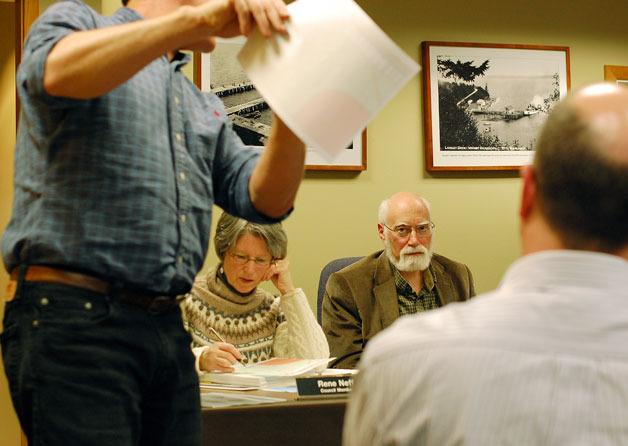The Langley City Council got some dirty news this week when it learned of a few water quality issues from a team of county health officials.
The group, which also included Island County Commissioner Helen Price Johnson, attended the council’s regular meeting at City Hall on Monday at the behest of Councilman Hal Seligson.
He asked them to come and talk about the county’s septic system inspection regulations. While much of the discussion centered on the rules and the general management of water resources in the county, health department leaders also addressed concerns specific to Langley.
Keith Higman, director of Island County Public Health, said properly operating septic systems are an essential part of protecting groundwater. Langley gets its drinking water from deep and shallow wells and some have been found to contain nitrates.
“They are well below the maximum contaminant level,” he said. “I’m not trying to suggest you be overly concerned, but as purveyors of water to a large population, it’s one of the things you need to keep an eye on,” he said.
Also, levels of fecal coliform bacteria have been discovered in a water basin — not a drinking water supply — on the west side of town. Found in the feces of living things, the bacteria is not necessarily dangerous by itself but it can be a marker for other harmful pathogens that can lead to dysentery or even typhoid fever.
According to Jill Wood, environmental health director for public health, the testing that revealed the bacteria’s presence took place in 2008 and 2009. Results were normal for most of the year except during the dryer summer months.
Additional testing has since taken place and levels were found to be within acceptable standards. However, Wood said more sampling is needed during the summer months to gather more data.
Responding to a query by Councilwoman Rene Neff about livestock and septic systems in that area, Wood said she doubted the bacteria is the result of a single problem.
“It’s very unlikely that it’s one particular source, but a combination of all the sources,” Wood said.
They may range from increases in population to people not picking up pet waste, which has been attributed to the problems in Holmes Harbor that resulted in the establishment of a shellfish protection district.
Mayor Larry Kwarsick asked about testing of the Edgecliff outfall on the east side of town. Although it is a county outfall, he said Langley is a “huge contributor” as many of the homes in that area are on septic systems.
“I’d be very interested in testing that,” he said.
In a later interview, Kwarsick said he wasn’t too alarmed by the county’s report, largely because the negative results were found in the summer months. During the dry season, when there is less water flow, any bacteria in the stream will be more concentrated and is more likely to show up on tests, he said.
Seligson also said later that while the problem was news to him, he’s not losing any sleep over the matter. Water quality is very important to him, but this doesn’t appear to be a big problem.
He applauded the county’s efforts and said the their willingness to come and speak with the council about water quality issues bodes well for future partnerships, which he said is important considering the number of homes in Langley that are on private septic systems.
“It gives me reason to believe that we can have a productive relationship with the county,” Seligson said.



